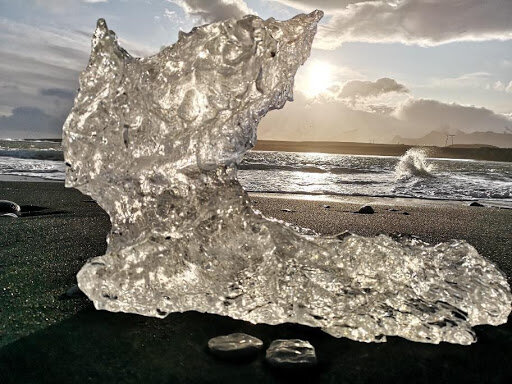
July 2021 Newsletter
Published July 1st at 10:00am PST
Fireflies in the Garden
BY ROBERT FROST
Here come real stars to fill the upper skies,
And here on earth come emulating flies,
That though they never equal stars in size,
(And they were never really stars at heart)
Achieve at times a very star-like start.
Only, of course, they can't sustain the part.
Table of Contents
July Astrological Events
Volcanoes and What They Mean for Humanity
Photo Gallery by EC Member Sam Townson
G7 Summit 2021: All you need to know.
Cities that are Saving the Planet
Green Stormwater Infrastructure and Stormwater Management
Energy Calculator
Energy Hour
Fauna Coloring Pages
Organization Updates: Trademark and Fundraisers
JULY ASTRONOMICAL EVENTS
ASTRO BOY
July 4: Mercury at Greatest Western Elongation
July 10: New Moon
July 24: Full Moon
July 28, 29: Delta Aquarids Meteor Shower
Watch this video to learn a little bit about how Hubble’s photos are produced and see some of the amazing photos explained!
VOLCANOES AND WHAT THEY MEAN FOR HUMANITY
GIO BLAST
By Abrar Hasanat
Volcanoes have always been a subject of interest amongst human beings. The massive entity, which is usually perceived for its destructive nature, is known by almost everyone young and old. The dictionary definition of a Volcano being, “ a mountain with a large, circular hole at the top through which lava (= hot liquid rock) gases, steam, and dust are or have been forced out.”₁
For most people, a Volcano is a big, evil structure whose only work is to cause destruction; basically a villain sort of presence. With the eruptions of Mount Vesuvius or Mount Ruiz which killed thousands - they’re not really wrong.
Yet, volcanoes can also be termed as underappreciated heroes. Volcanoes have been working for mother nature and (in a way) humanity from before there were any human beings on this earth. From scientific breakthroughs to being the reason the Earth is habitable - they have a role in everything! And that’s what we are going to discuss today!
FIRST LAND:
As unbelievable as it may sound, volcanoes may be the reason there is land! The materials which were being accumulated due to the formation of the Earth came together with varying degrees of violence. Originally, there was a friction of colliding materials and a spinning molten mass was formed, which in turn cooled down - making a surface layer. Over time, however, the surface thickened into more permanent layers. The volcanic eruptions continued, but those permanent layers had formed the first land.₂ These eruptions released a huge amount of gasses which consequently helped in…
CREATING THE ATMOSPHERE:
Around 4.6 billion years ago, Earth was a mix of hot gasses and solids with no hint of an atmosphere whatsoever. But as it cooled down, an atmosphere was formed from the gasses which were released by volcanoes. It included hydrogen sulfide, methane, and ten to 200 times as much carbon dioxide as today’s atmosphere. And then, half a BILLION years later - these became cooled and solidified enough and thus came the₃…
BEGINNING OF WATER:
Over 4.5 billion years, the amount of water that has been produced by volcanoes has actually given us the water that we have on Earth, said Concord University volcanologist, Dr. Janine Krippner.₄ A simple explanation is: Earth’s interior contains minerals with hydrogen and oxygen. Volcanoes continually were ‘degassing or ‘outgassing’ and releasing H2O as water vapor. Now, the water should’ve been vaporized due to the intense heat of the magma; however, Earth’s surrounding atmosphere gradually cooled down. After some time Earth’s surface cooled below the boiling point of water, then instead of water evaporating into space, rain began draining into ocean basins. Thus came the water!₅
So, pretty intriguing right? The volcanoes in a way are the very reason why human beings can survive on this earth. I mean, imagine an Earth but with no land, water or atmosphere! Sounds pretty impossible right? And that’s why human life would’ve been impossible without something most people don’t even consider as a good thing, volcanoes.
Now the question is, are these volcanoes still important? The answer is - Absolutely!
SOIL ENRICHMENT:
Volcanic dust, ash, and rocks decompose into soils with an exceptional ability to hold nutrients and water, making the soil very fertile. While the most abundant elements in magma are silica and oxygen, eruptions also result in the release of H₂O, carbon dioxide (CO²), sulfur dioxide (SO²), hydrogen sulfide (H²S), and hydrogen chloride (HCl), amongst others.₃
GLOBAL COOLING:
Now I know what you’re thinking, “How can a volcano, which erupts lava, contribute to global cooling?” But, surprisingly it can. When volcanic ash and compounds like sulfur dioxide are released into the atmosphere, it can reflect some of the Sun's rays back into space. This reduces some of the heat which is usually absorbed by the atmosphere. This cooling process is known as “Global Dimming”.₃
EXPANSION OF LAND:
Even though volcanoes made most of their impact a few billion years ago by MAKING land, they didn’t end there. Volcanic eruptions continue to add land, whether by extending existing land, as in Hawaii or by bringing new islands to the surface, as at Surtsey, an island that emerged in 1963 along the mid-ocean ridge near Iceland.₂
There are several other advantages of volcanoes in the modern age. Like: the use of geothermal energy, attracting tourists, etc. But you get the point that these “older-than-land” volcanoes are still helping humanity!
Despite their reputation as destructive forces, volcanoes were actually an integral part of the development of life on Earth. Without volcanoes, most of Earth's water would still be trapped in the crust and mantle; the creation of the second atmosphere (which is the modern atmosphere we have now) would not have been possible; we would have no land to live on since the components in the interior of Earth would all be accumulated together without any layers. The volcanic eruptions in the early times resulted in the creation of the second atmosphere which is the modern atmosphere we have now.₂ Besides water and air, volcanoes are responsible for land, another necessity for many life forms. volcanoes may be devastating at the moment, but ultimately Earth's life would not be the same, if it existed at all, without volcanoes. So we can say that surely they are under-appreciated and the impact of volcanoes is far greater than what the average person thinks.
Works Cited:
“Volcano.” Cambridge Dictionary. Accessed July 1, 2021. https://dictionary.cambridge.org/dictionary/english/volcano.
Blaettler, Karen G. “What Is the Importance of Volcanoes to Life on Earth?” Sciencing, March 2, 2019. https://sciencing.com/importance-volcanoes-life-earth-10048990.html.
Cain, Fraser. “What Are the Benefits of Volcanoes?” Phys.org. Phys.org, March 21, 2016. https://phys.org/news/2016-03-benefits-volcanoes.html.
Williams, Ashley. “6 Ways Volcanoes Benefit Earth, Our Environment.” AccuWeather. Accessed July 1, 2021. https://www.accuweather.com/en/weather-news/6-ways-volcanoes-benefit-earth-our-environment/348155.
“Did Earth's First Water Come from Comets, Volcanoes or Asteroids?” Earth How, January 18, 2021. https://earthhow.com/origin-of-water-comets-volcanoes-outgassing/.
PHOTO GALLERY
MR. GREEN
By Sam Townson
All photos were taken by our E.C. member, Sam. This is a selection of some of his favorite photos. His work will be taking over our instagram throughout the month so make sure to keep your eye out for these and maybe even some surprises!
Photos of Nepal were taken on a Pentax K50 DSLR camera.
All other photos were taken on a Huawei P20 Pro cell-phone with some Instagram or Snapseed edits.

July 2017 - Muktinath, Nepal - A break from the trek

July 2017 - Pokhara, Nepal - A view from the roof tops

August 2020 - Ben Nevis North Face, Scotland - Ascending into the clouds

July 2017 - Ghasa, Nepal - Brushing your teeth with a view

August 2020 - Loch Slapin, Isle of Skye, Scotland - Wildcamping on the waterfront

August 2020 - Loch an Eilein, Scotland - Castle Island

August 2020 - Fairy Pools, Isle of Skye, Scotland - Wild swimming location

August 2020 - Fairy Glen, Scotland - A magical location

December 2020 - Bradford England - View from home on Christmas Day

September 2019 - Faxi, Iceland - A hidden gem away from the beaten track

September 2019 - Thingvellir, Iceland - Mirror pools in the tectonic national park

September 2019 - Gullfoss, Iceland - On the beaten track but cannot be missed

September 2019 - Skogafoss, Iceland - Caught in a shower

September 2019 - Diamond Beach, Iceland - Ice surfing

September 2019 - Diamond Beach, Iceland - An ice diamond on the black beach
G7 SUMMIT 2021: All you need to know.
CULTURE RADAR
By Sam Townson
G7 - What is it?
On the 11th June 2021 leaders from the world’s richest nations gathered in Cornwall as the United Kingdom hosted the 47th G7 Summit,₁ but what is the G7 Summit?
Well, G7 actually stands for the ‘Group of Seven’₁ and is made up of the ‘world’s leading democracies’.₂The nations and people at this year’s summit include:
Boris Johnson - UK
Joe Biden - USA
Justin Trudeau - Canada
Emmanuel Macron - France
Angela Merkel - Germany
Mario Draghi - Italy
Yoshihide Suga - Japan
Ursula von der Leyen - European Union
Now you might have spotted something untoward about that list...there are eight attendees.₃ This is because the European Union is not technically part of the G7 but still attends the G7 Summits as it is one of the world’s largest political blocs and is bound up in the G7’s open value of democracy and having an outward-looking global society.₄ This year India, South Korea and Australia were invited as guest countries.₂
Quick fact - the G7 was once the G8 but Russia was dismissed from the group in 2014 after it annexed Crimea.₁
At the G7 Summits the members discuss the issues the world is currently faced with ranging from economics to health to the climate crisis. For example, past summits have focused on developing countries and their need for debt relief, HIV and AIDS, and global security concerns.₁
The G7 Summit is a key moment in the global political calendar as it is a meeting of the world’s wealthiest and most powerful countries meaning decisions made at these summits reverberate across the world.₁
Quick fact - the first summit meeting of this style took place in France in 1975 with the then G6 Summit taking place between France, West Germany, the USA, Japan, the UK, and Italy.₅
G7 2021 - Is it special?
This year’s summit is not particularly special as it continues the routine of these countries and their leaders coming together every year. However, it has garnered extra attention for being Joe Biden’s first since becoming president and his first visit to Europe, the first in person since the beginning of the Coronavirus Pandemic, and the first of the two global gatherings the UK is hosting this year as we await COP26 coming in November.₅ The summit also comes at a time when the world sits on a precipice of the pandemic as the vaccine roll out gathers pace in some countries and remains strained in others.
Quick fact - COP26 is going to be the 26th United Nations Climate Change conference where members of the United Nations Framework Convention on Climate Change discuss the progress on tackling climate change.₆
On the agenda for the 47th Summit was the current climate crisis, the global pandemic, and global economic recovery from the pandemic with an aim to ‘Build Back Better’.₇ So, what decisions were made and what do they mean?
What happened?
The first, and potentially most immediate, decision made at this year’s G7 Summit was regarding the COVID-19 vaccines. Over the next year the G7 leaders have pledged to deliver 870 million vaccine doses to low income countries on top of the 350 million already promised by the US and UK.₇ The World Health Organisation welcomed this generosity, but highlighted the need for further action showing the actual need to be around 11 billion vaccines.₈
Quick fact - over 2.7 billion vaccine doses have been given globally, yet some countries are yet to administer a single dose.₉
Moreover, the group made moves to implement frameworks which would improve the world’s defence against and resilience to global health threats in the future with an increase in early warning systems and support for vaccine development.₁₀
The attention then moved to ‘building back better’ as G7 nations invest, as part of the Build Back Better World (B3W) initiative, in infrastructure projects globally focused on recovery from the pandemic, fighting climate change, and improving global inequality.₈ The nations also hope to strengthen their own economies with a focus on creating jobs, driving innovation, and ensuring equal opportunities so no person or place is ‘left behind’.₁₀
Action was also taken against global technology companies to ensure technological progress is for the common good and inaccord with the G7’s values of creating a resilient global economy with a’fair global tax system’.₁₀ The G7 nations agreed to implement measures to dissuade multinational corporations from shifting their profits into low tax havens.₈ This agreement was backed by leaders signing up to a global minimum corporation tax rate of 15%.₈
Quick fact - it is estimated the reforms will generate as much as $81bn (£57bn) in additional tax revenue a year.₁₁
Finally, the leaders discussed the state of the environment and the climate crisis. All nations pledged to phase out coal power generation and end funding for new coal power plants in low income countries with funding offered to help these nations develop cleaner energy.₁₁ The nations also pledged to meet net zero by 2050 and aim to conserve 30% of land and oceans by 2030.
Quick fact - currently only 15% of land and 7% of ocean is under some degree of protection.₁₂
What does it all mean?
These decisions illustrate that there is still a way to go to tackle the global pandemic and that this is still the primary focus of the world’s wealthiest nations. Steps are being made in the right direction as vaccines are rolled out globally and there is talk of building back better as well.
However, it is clear the global community is still faced by serious threats. We are in the midst of a global pandemic, global corporations are attempting to exploit the global economy for their own gains, and the climate crisis looms over us demanding immediate action.
Works Cited:
The Catholic Agency for Overseas Development (CAFOD). (2021) G7 Summit 2021: What is the G7, when is it meeting and where is the summit taking place?. CAFOD. (Online). (Accessed 23 June 2021). Available from: https://cafod.org.uk/Campaign/Reclaim-our-common-home/What-is-the-G7-Summit-2021
G7 UK. (2021a) G7 United Kingdom 2021 - Build Back Better. G7 UK 2021. (Online). (Accessed 23 June 2021). Available from: https://www.g7uk.org/
Bain, E. (2021) Who is at the G7 Summit? All the world leaders who are in Cornwall this weekend. HITC. (Online). (Accessed 23 June 2021). Available from: https://www.hitc.com/en-gb/2021/06/12/who-is-at-the-g7-summit/
Tua, M. (2021) G7 SUmmit: what is the G7 and why is it being held in Cornwall this year? The Express. (Online). (Accessed 23 June 2021). Available from: https://www.express.co.uk/news/uk/1446914/G7-summit-2021-what-is-G7-summit-why-g7-in-Cornwall-EVG
G7 Germany. (2021) From Rambouillet to Brussels - the history of the G7. The Federal Government - G7 Germany. (Online). (Accessed 23 June 2021). Available from: https://www.g7germany.de/Content/EN/StatischeSeiten/G7_elmau_en/texte_en/2014-11-05-geschichte-g8.html
Huda, Z. (2021) What is COP26 and how does it impact climate change? Planet Shine. (Online). (Accessed 23 June 2021). Available from: https://planetshine.com/what-is-cop26/
Broom, D. (2021) Global solutions: four things that came out of the G7 Summit. World Economic Forum. (Online). (Accessed 23 June 2021). Available from: https://www.weforum.org/agenda/2021/06/g7-summit-covid19-tax-environment/
Bunici, D. (2021) Explainer: What happened at this year’s G7 Summit? Extra.ie. (Online). (Accessed 23 June 2021). Available from: https://extra.ie/2021/06/14/news/world-news/what-happened-g7-summit-2021
Holder, J. (2021) Tracking Coronavirus Vaccinations Around the World. New York Times. (Online). (Accessed 23 June 2021). Available from: https://www.nytimes.com/interactive/2021/world/covid-vaccinations-tracker.html
G7 UK. (2021b). Caris Bay G7 Summit Communique. G7 UK 2021. (Online). (Accessed 23 June 2021). Available from: https://www.g7uk.org/wp-content/uploads/2021/06/Summary-of-Carbis-Bay-G7-Summit-Communique-PDF-248KB-2-Pages.pdf
Partington, R. (2021) G7 tax reform: what has been agreed and which companies will it affect? The Guardian. (Online). (Accessed 23 June 2021). Available from: https://www.theguardian.com/world/2021/jun/07/g7-tax-reform-what-has-been-agreed-and-which-companies-will-it-affect
George, S. (2020) Protect one-third of world’s oceans and land to deliver $500bn economic boost, scientists urge. Edie. (Online). (Accessed 23 June 2021). Available from: https://www.edie.net/news/4/Protect-one-third-of-world-s-oceans-and-land-to-deliver--500bn-economic-boost--scientists-urge/
“CITIES THAT ARE SAVING THE WORLD”
FLORA FERN
Amy found this video and thought it paired perfectly with last month’s article on GSIs by Abrar. It even touches on Sam’s article about the relationship between urban environments and nature! Enjoy this beautiful and educational short video to see what GSIs and other green infrastructure can look like.
Continue below to read more in Abrar’s article, and click here to find Sam’s.
GREEN STORMWATER INFRASTRUCTURE AND STORMWATER MANAGEMENT
CRYSTAL CLEAR [Archive]
By Abrar Hasanat
A relatively new term in the world of infrastructures and climatic issue management is the Green Stormwater Infrastructure. Even though the term first originated back in the 1980s, it wasn’t until the late 1990s that scientists really looked into the idea. A mission started to change the older system which was in place and turn that into something better.(1) This upgraded and more efficient system that replaced the previous one is none other than the Green Stormwater Infrastructure which we’ll be discussing today!
According to PennFuture:
“Green Stormwater Infrastructure (GSI) is a nature-based solution to water quality issues that urban stormwater runoff causes and provides greater benefits than conventional (or “Gray”) stormwater solutions…GSI is defined as soil-water-plant systems that intercept stormwater, infiltrate a portion of it into the ground, evaporate a portion of it into the air, and in some cases release a portion of it slowly back into the sewer system”.(2)
Types of GSI:
Urban Forests: Urban forests are forests located in cities. They are an important component of urban green infrastructure systems. Urban forests use appropriate tree and vegetation species, instead of noxious and invasive kinds, which reduce the need for maintenance and irrigation. In addition, native species also provide aesthetic value while reducing cost.(3)
Green and blue roofs: Green-blue roofs improve air and water quality while reducing energy costs. The blue-green roof combines blue and green roof technologies. Conventional green roofs conventional use a drainage layer to provide lateral drainage and irrigation. Blue roof technology, however, aims to increase both the volume of water stored and control the amount of water released. The plants and soil provide more green space and insulation on roofs. Green and blue roofs also help reducing city runoff by retaining rainfall providing a solution for stormwater management in highly concentrated urban areas. Blue roofs, not technically being green infrastructure, collect and store rainfall, reducing the inrush of runoff water into sewer systems.(4)
Rain Gardens: Rain gardens are a form of stormwater management using water capture. Rain gardens are shallow depressed areas in the landscape, planted with shrubs and plants that are used to collect rainwater from roofs or pavement and allows for the stormwater to slowly infiltrate into the ground.(5)
Downspout disconnection: Downspout disconnection is a form of green infrastructure that separates roof downspouts from the sewer system and redirects roof water runoff into permeable surfaces. It can be used for storing stormwater or allowing the water to penetrate the ground. Downspout disconnection is especially beneficial in cities with combined sewer systems.(6)
GSI is a cost-effective approach to managing wet weather impacts that provides many community benefits. Stormwater runoff in urban areas causes water pollution by clogging the drainage systems, carry debris and trash, spreads bacterias, etc. Keeping these in mind, the GSI was designed to move urban stormwater away from the built environment, since it reduces and treats stormwater at its source while delivering environmental, social, and economic benefits.(7)
Benefits of GSI: (8)
Environmental:
Habitat and Biodiversity. Green streetscapes enhance urban biodiversity as native species provide habitats for birds, insects, and other species.
Water Quality. Green infrastructure improves stormwater quality by reducing the load of sediment, unwanted minerals, and other contaminants that are carried with runoff from impermeable surfaces.
Natural Hydrology. Where local soils are suitable, rain gardens are used to treat stormwater before it permeates the groundwater.
Passive Irrigation. Directing stormwater to irrigate the farmland reduces the need for manual watering and increases soil moisture.
Social:
Amenity and Landscape Design. Landscape design contributes to a city’s character and identity. Planting complements the built environment, softens the appearance of hard surfaces, and provides a visual screen.
Urban Cooling. Trees and green infrastructure provide significant reductions in urban temperatures. Large trees with good soil moisture can reduce local temperatures through shading and evapotranspiration.
Encourage Outdoor Activity. Green cover encourages outdoor activity, including walking, cycling, and other recreation.
Air Quality. Vegetation improves air quality and reduces greenhouse gases. Trees remove carbon dioxide, nitrous oxides, sulfur dioxide, carbon monoxide, and ozone from the atmosphere.
Economic:
Energy. By reducing local temperatures and shading building surfaces, green infrastructure reduces the cooling demand of buildings, thus cutting energy needs.
The lifespan of Infrastructure. Green infrastructure complements grey infrastructure (Grey infrastructure refers to the human-engineered infrastructure for water resources such as water and wastewater treatment plants, pipelines, and reservoirs) such as catch basins and drainage pipes and lengthens the lifespan of grey infrastructure.
Water Systems. The impacts on drainage systems and the cost of managing erosion in waterways can be significant. Streets with green infrastructure slow the rate of runoff, reducing the pressure on these systems and lowering maintenance costs.
Property Values and Marketability. Street trees and green infrastructure enhance aesthetic qualities and provide a significant neighborhood amenity. Properties on tree-lined streets are valued at up to 30% more than those on streets without trees.
One might ask, is it more expensive to use greener interventions than the traditional ones? Well, no. Directly comparing the maintenance costs of stormwater infrastructure by unit area of green infrastructure, vegetated systems (the older traditional methods) generally are more expensive to maintain than subsurface and non-vegetated systems (green infrastructures). Addressing stormwater runoff and other water-related challenges is getting insanely expensive, which is why cost-effective green interventions are on the rise.(9)
So why aren’t these still massively used? The main reason is overcoming the barriers which have been set for a long time. Some of these barriers include: (7)
The perception that performance is unknown
The perception of higher costs
The perception of resistance within Regulatory Community
Perception of Conflict with Principles of Smart Growth
Unfamiliarity with Maintenance Requirements and Costs
Lack of Government Staff Capacity and Resources
Skepticism about Long-Term Performance
We can provide the solutions right now but that will make the article much larger than it should be. So perhaps let’s keep it for a later day!
So, at the very end, I’ll say - the Green Stormwater Infrastructure is actually very important for the future if we really want to work for a better and cleaner environment. Municipal and community leaders are beginning to understand that green infrastructure can deliver numerous economic and environmental benefits—as well as helping to correct age-old planning policies that create social divisions. That means more parks, open space, and other amenities, for instance, can be built in formerly neglected neighborhoods, boosting the health and well-being of everyone.
There are plenty of ways green infrastructure can be used on a smaller scale as well, including in our own homes. Simple strategies range from the use of disconnected downspouts and porous surfaces for outdoor spaces to the planting of native gardens. Modernizing regulations at the national, state and local levels is a crucial step for driving the use of green infrastructure.
Works Cited:
“Controlling Urban Runoff.” Metropolitan Washington Council of Governments. Metropolitan Washington Council of Governments, July 1, 1987. https://www.mwcog.org/documents/1987/07/01/controlling-urban-runoff-bmp-stormwater/.
“What Is Green Stormwater Infrastructure?” PennFuture. Accessed May 31, 2021. https://www.pennfuture.org/what-is-green-stormwater-infrastructure.
“Professional Practice: Green Infrastructure: Cities.” American Society of Landscape Architects. Accessed May 31, 2021. https://www.asla.org/ContentDetail.aspx?id=43535.
Shafique, Muhammad, and Reeho Kim. “Retrofitting the Low Impact Development Practices into Developed Urban Areas Including Barriers and Potential Solution.” De Gruyter. De Gruyter Open, June 20, 2017. https://www.degruyter.com/document/doi/10.1515/geo-2017-0020/html.
“Green Infrastructure: Rain Gardens.” The Watershed Institute, June 11, 2019. https://thewatershed.org/green-infrastructure-rain-gardens/.
“Downspout Disconnection.” MMSD. Accessed May 31, 2021. https://www.mmsd.com/what-you-can-do/downspout-disconnection.
“Benefits of Green Infrastructure.” United States Environmental Protection Agency. Environmental Protection Agency. Accessed May 31, 2021. https://www.epa.gov/green-infrastructure/benefits-green-infrastructure#:~:text=Green%20infrastructure%20also%20treats%20stormwater,slowing%20and%20reducing%20stormwater%20discharges.
“Benefits of Green Infrastructure.” Global Designing Cities Initiative. Accessed May 31, 2021. https://globaldesigningcities.org/publication/global-street-design-guide/utilities-and-infrastructure/green-infrastructure-stormwater-management/benefits-green-infrastructure/.
“As Costs Rise, Green Infrastructure Looks Better And Better.” Ecosystem Marketplace, May 31, 2017. https://www.ecosystemmarketplace.com/articles/as-costs-rise-green-infrastructure-looks-better-and-better/.
ENERGY GIRL
Quinn Gagos
If you’ve been with us for awhile, you probably remember this super cool tool!
With hot weather on the rise where I live, increasing use of energy in the household is noticeable. With the air conditioner becoming a more constant white noise, I am also noticing the sounds of the other appliances like our dryer. And then I started thinking about my laptop charger, lights, microwave, etc. So much energy, but how much is it really? And how much does it cost?
Well, now you can know! Click the button below to access an energy calculator. You can input different appliances, your state, and how often you use it. Unfortunately for Earthians outside of the United States, this calculator is made by the USA government so energy rates aren’t available for other countries, but you can still get wattage and calculate with a little research for the rates where you live.
ENERGY HOUR
Tuesdays from 7pm-8pm
Turn off all energy-using lights, appliances, and heating/cooling systems!
If you're wondering what to do without TV or a laptop charger here's some ideas!
-Color, Arts and Crafts
-Puzzles: jigsaw, crosswords
-Board Games
-Clean
-Talk to your housemates!
FAUNA COLORING PAGES
CRITTER CORNER
Click and download your favorite coloring pages! Coloring is a great way to destress either by yourself or with friends and family. So grab your markers, crayons, or colored pencils! Or maybe your good with technology and can color them in on your screen! Although, personally, we encourage a break from looking at a screen [after reading our whole newsletter of course ;) ].













UPDATES!
We first filed for a trademark in 2010 and became officially registered in 2012. Just last month in May 2021 our renewal became official! We are so excited to have this extra layer of protection to our brand as we look to the future and expanding! A huge thank you to Mitch Gagos for making this possible not once, but twice!
We currently have two fundraisers going: Earthians Care Scholarship Fund and Earthians Care Operations Fund. Click the button above for more information on each fundraiser and how funds will be used. Your support is crucial to our ability to meet our goals as an organization. Any amount helps greatly. We were so overwhelmed with the generosity of our community in our first scholarship fundraiser and want to say Thank You again!
We also now have a Venmo! You can donate through GoFundMe or Venmo. If using Venmo, please designate which fund you would like to contribute to.






